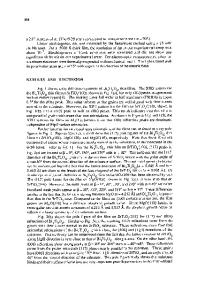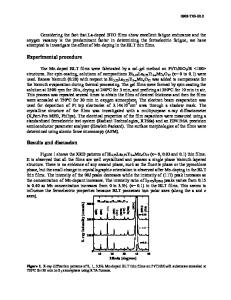Low crystallization temperature and unusual switching properties of ferroelectric Nb-doped Bi 4 Ti 3 O 12 thin films pre
- PDF / 184,895 Bytes
- 5 Pages / 612 x 792 pts (letter) Page_size
- 52 Downloads / 368 Views
Sang Su Kim Department of Physics, Institute of Basic Science, Changwon National University, Changwon, Kyungnam, 641-773, Korea
Jinheung Kima) Department of Chemical Technology, Institute of Basic Science, Changwon National University, Changwon, Kyungnam, 641-773, Korea (Received 16 January 2003; accepted 19 May 2003)
Nb-doped Bi4Ti3O12 (Nb-BIT) ferroelectric thin films were prepared in the presence of a nonionic surfactant (pluronic P123) added as an additive to the sol solution and by rapid thermal annealing (RTA). The film annealed at the relatively low temperature of 600 °C was well crystallized and showed good ferroelectricity. The switching charge of capacitors with polarization reversal rapidly increased with a large amplitude and low frequency of the applied pulse, and gradually decreased with a small amplitude and high frequency. The remanent polarization (2Pr) after subjecting the Nb-BIT capacitors to 108 read/write cycles was 46 C/cm2, which is remarkably higher than 20 C/cm2 observed in the initial state. These phenomena seem to appear by the presence of space charges trapped after heat treatment by the RTA process.
I. INTRODUCTION
Bismuth oxide layer-structured ferroelectrics (BLSFs), such as SrBi2Ta2O9 (SBT) and Bi4Ti3O12 (BIT), have attracted much attention in recent years as promising materials for applications in nonvolatile ferroelectric random-access memories because of their lead-free and fatigue-free ferroelectric properties.1–3 However, low processing temperature and large remanent polarization are constantly required for BLSFs to replace the conventional lead-based materials. Recently, substitution of a small amount of impurities, such as La and Sm for Bi and V sites, and Nb for Ti sites in the pseudoperovskite (Bi2Ti3O10)2− blocks of BIT, was reported to be effective for enhancing the remanent polarization.4–6 We also reported the large remanent polarization of Nb-doped BIT thin films annealed at 700 °C by conventional furnace annealing.7 However, the BIT and Nb-doped BIT films with large ferroelectricities are limited to the films prepared at relatively high temperatures above 650 or 700 °C. More recently, Watanabe et al. reported that the cosubstitution of La and V in BIT thin films prepared by
a)
Address all correspondence to this author. e-mail: [email protected]
1884
http://journals.cambridge.org
J. Mater. Res., Vol. 18, No. 8, Aug 2003 Downloaded: 15 Mar 2015
metalorganic chemical vapor deposition afforded a large ferroelectricity at relatively low deposition temperature (600 °C) because the simultaneous substitutions for both sites were effective to derive enough feroelectricity by accelerating the domain nucleation.8 Meanwhile, BLSF ferroelectric thin films deposited on Pt electrodes are known to show essentially fatigue-free properties upon polarization. However, only a few studies about the increase in the switching charge of the sol-gel-derived SBT and Bi3.25La0.75Ti3O12 (BLT) magnified thin films during polarization reversal have been reported.9–12 They repo
Data Loading...











